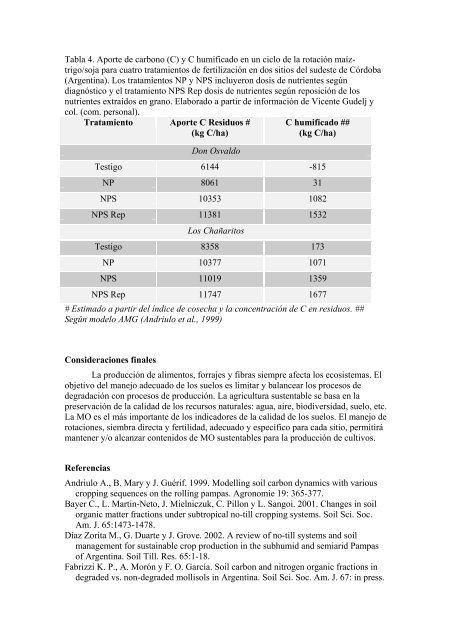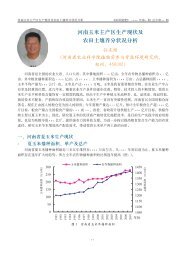SD rotación de cultivos y materia orgánica
SD rotación de cultivos y materia orgánica
SD rotación de cultivos y materia orgánica
You also want an ePaper? Increase the reach of your titles
YUMPU automatically turns print PDFs into web optimized ePapers that Google loves.
Tabla 4. Aporte <strong>de</strong> carbono (C) y C humificado en un ciclo <strong>de</strong> la <strong>rotación</strong> maíztrigo/soja<br />
para cuatro tratamientos <strong>de</strong> fertilización en dos sitios <strong>de</strong>l su<strong>de</strong>ste <strong>de</strong> Córdoba<br />
(Argentina). Los tratamientos NP y NPS incluyeron dosis <strong>de</strong> nutrientes según<br />
diagnóstico y el tratamiento NPS Rep dosis <strong>de</strong> nutrientes según reposición <strong>de</strong> los<br />
nutrientes extraídos en grano. Elaborado a partir <strong>de</strong> información <strong>de</strong> Vicente Gu<strong>de</strong>lj y<br />
col. (com. personal).<br />
Tratamiento Aporte C Residuos #<br />
(kg C/ha)<br />
Don Osvaldo<br />
C humificado ##<br />
(kg C/ha)<br />
Testigo 6144 -815<br />
NP 8061 31<br />
NPS 10353 1082<br />
NPS Rep 11381 1532<br />
Los Chañaritos<br />
Testigo 8358 173<br />
NP 10377 1071<br />
NPS 11019 1359<br />
NPS Rep 11747 1677<br />
# Estimado a partir <strong>de</strong>l índice <strong>de</strong> cosecha y la concentración <strong>de</strong> C en residuos. ##<br />
Según mo<strong>de</strong>lo AMG (Andriulo et al., 1999)<br />
Consi<strong>de</strong>raciones finales<br />
La producción <strong>de</strong> alimentos, forrajes y fibras siempre afecta los ecosistemas. El<br />
objetivo <strong>de</strong>l manejo a<strong>de</strong>cuado <strong>de</strong> los suelos es limitar y balancear los procesos <strong>de</strong><br />
<strong>de</strong>gradación con procesos <strong>de</strong> producción. La agricultura sustentable se basa en la<br />
preservación <strong>de</strong> la calidad <strong>de</strong> los recursos naturales: agua, aire, biodiversidad, suelo, etc.<br />
La MO es el más importante <strong>de</strong> los indicadores <strong>de</strong> la calidad <strong>de</strong> los suelos. El manejo <strong>de</strong><br />
rotaciones, siembra directa y fertilidad, a<strong>de</strong>cuado y específico para cada sitio, permitirá<br />
mantener y/o alcanzar contenidos <strong>de</strong> MO sustentables para la producción <strong>de</strong> <strong>cultivos</strong>.<br />
Referencias<br />
Andriulo A., B. Mary y J. Guérif. 1999. Mo<strong>de</strong>lling soil carbon dynamics with various<br />
cropping sequences on the rolling pampas. Agronomie 19: 365-377.<br />
Bayer C., L. Martin-Neto, J. Mielniczuk, C. Pillon y L. Sangoi. 2001. Changes in soil<br />
organic matter fractions un<strong>de</strong>r subtropical no-till cropping systems. Soil Sci. Soc.<br />
Am. J. 65:1473-1478.<br />
Díaz Zorita M., G. Duarte y J. Grove. 2002. A review of no-till systems and soil<br />
management for sustainable crop production in the subhumid and semiarid Pampas<br />
of Argentina. Soil Till. Res. 65:1-18.<br />
Fabrizzi K. P., A. Morón y F. O. García. Soil carbon and nitrogen organic fractions in<br />
<strong>de</strong>gra<strong>de</strong>d vs. non-<strong>de</strong>gra<strong>de</strong>d mollisols in Argentina. Soil Sci. Soc. Am. J. 67: in press.

















